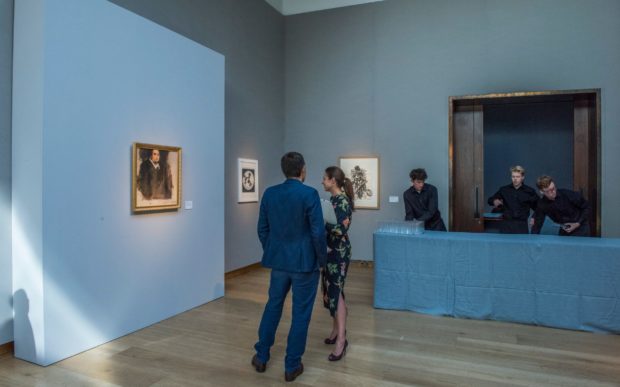Artificial Intelligence Artwork Set for Sale in NY
Two paintings up for auction in New York highlight a growing interest in artificial intelligence-created works — a technique that could transform how art is made and viewed but is also stirring up passionate debate.
The art world was stunned last year when an AI painting sold for $432,500, and auctioneers are keen to further test demand for computer-generated works.
“Art is a true reflection of what our society, what our environment responds to,” said Max Moore of Sotheby’s.
#AuctionUpdate The first AI artwork to be sold in a major auction achieves $432,500 after a bidding battle on the phones and via ChristiesLive https://t.co/XiDVxVGa1n pic.twitter.com/7dxirT55i8
— Christie's (@ChristiesInc) October 25, 2018
“And so it’s just a natural continuation of the progression of art,” he added.
Sotheby’s will put two paintings by the French art collective Obvious up for sale on Thursday, including “Le Baron De Belamy.”
The European classic style portrait is part of the same series as “Portrait of Edmond Belamy”, which sold for more than 60 times the lowest estimate at Christie’s during the 2018 fall auctions.
The paintings were made using a technique called “generative adversarial network,” or GAN.
GAN involves feeding thousands of images of the same style into a computer until the machine concludes that it has created a new portrait that it thinks accurately reflects that style.
“Katsuwaka of the Dawn Lagoon” was created in a Japanese style using the same GAN algorithm.
Auctioneers have put modest prices on the two paintings. “Katsuwaka” has a pre-sale estimate between $8,000 and $12,000, while “Le Baron” has been priced between $20,000 and $30,000.
“We do not expect as big a result as last year,” said Pierre Fautrel, one of the three members of Obvious.
“We just want to see if there are people who are ready to buy around these prices and if the market will continue to build,” he added.
Moore said the sale of “Portrait of Edmond Belamy” showed that there is “a marketplace for this new body of work” but that it’s still “in the very early stages.”
“That will be a good indicator of where the market is,” he said.
In the fledgling artificial intelligence market, Obvious is not the most sought-after group of artists.
Not for Everyone
Steven Sacks, owner of the bitforms gallery in New York says his client, the Canadian-Mexican artist Rafael Lozano-Hemmer has already made around $600,000 for an AI artwork.
Whereas Obvious’s paintings are fixed, most of Lozano-Hemmer’s works use software to change in real-time according to data about each viewer’s perspective.
Other prominent AI artists who are exhibiting their work across the world include Germany’s Mario Klingemann and Turkish-born Refik Anadol.
Klingemann also makes portraits, sometimes tweaking the input data with voluntary glitches to avoid replication. Anadol uses mostly video to produce abstract data-based animations.
Klingemann’s “Memories of Passersby I”, a stream of portraits created by a machine, sold for $40,000 at Sotheby’s in London in March.
Sacks and several other artists AFP spoke to were critical of the “Bellamy” sale last year.
They feel that that painting is not representative of the potential of AI and argues that Obvious is imitating other works whereas they are creating something new.
“For me, it was a problem because it wasn’t authentic,” said Sacks, who subscribes to a school of thought that works made by AI should constantly be changing, usually on screens.
Some also criticize Obvious for giving the impression that AI can create works of art without human interference.
Related Articles
“An artist chooses. He lightens, he reinforces. Can a computer do that?” asks French painter Ronan Barrot, who has collaborated with British AI artist Robbie Barrat.
The debate continues to rage. Fautrel of Obvious denies that his collective merely imitates other artworks and sees AI as a “tool” and not an end in itself.
Despite their differences, they all agree the market for AI paintings is growing and that the sale of “Bellamy” has drawn attention to the burgeoning technique.
“I don’t think this new style is for everyone but I think you’re going to start catching the attention of a lot of people that aren’t necessarily art collectors but are very interested in the technology behind AI,” said Sotheby’s Moore.
Inquirer.net will receive a commission on purchases made*


